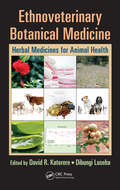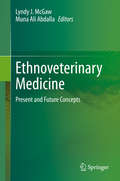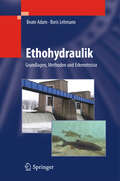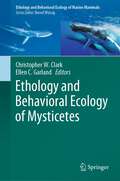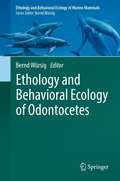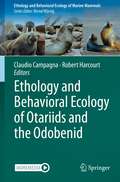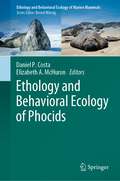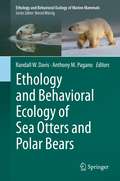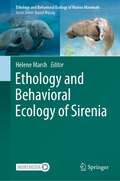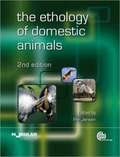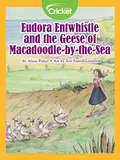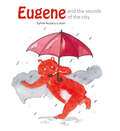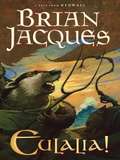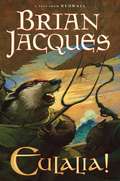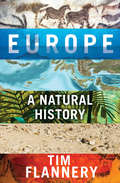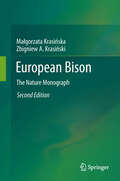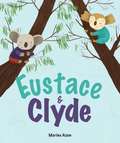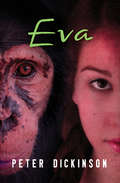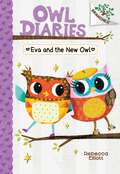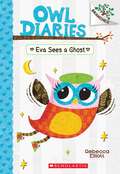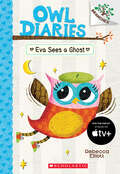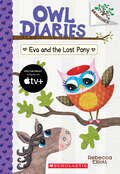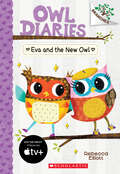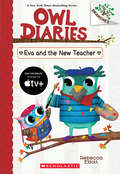- Table View
- List View
Ethnoveterinary Botanical Medicine: Herbal Medicines for Animal Health
by David R. Katerere Dibungi LusebaDespite the undoubted success of a scientific approach to pharmaceuticals, the last few decades have witnessed a spectacular rise in interest in herbal medicinal products. This general interest has been followed by increasing scientific and commercial attention that led to the coining of the term ethnopharmacology to describe the scientific discipl
Ethnoveterinary Medicine: Present and Future Concepts
by Lyndy J. McGaw Muna Ali AbdallaThe importance of a complementary approach to animal health is highlighted in this book, with core themes encompassing reviews of traditional veterinary medicine for common diseases afflicting livestock, as well as local practices in different areas of the world. The book includes chapters on ethnoveterinary medicine used to prevent and treat ticks and tick-borne diseases, infectious diseases and parasites. Ethnoveterinary practices in parts of the world which have not been comprehensively reviewed before are highlighted, including Estonia, Belarus and the Maghreb - the north-western tip of Africa. A fascinating account of African ethnoveterinary medicine and traditional husbandry practices is provided by a veteran in the field with a wealth of practical experience in the area. Neglected areas of research involve the relationship of ethnoveterinary medicine with environmental, ethical, cultural and gender aspects, and leading experts explore these issues.The book is intended to provide an informative compilation of current research and future prospects in ethnoveterinary medicine, which hopes to inform and encourage investigations in new directions. Sustainable development requires a concerted effort to combine indigenous knowledge systems with scientific research to improve animal health. This is the case not only in rural areas where access to orthodox veterinary health care may be limited, but also against the backdrop of antibiotic resistance and increased demand for alternative and complementary therapies to enhance the health of both production and companion animals. Students, academics and veterinary professionals will find this book a useful addition to knowledge on present and future aspects of ethnoveterinary research.
Ethohydraulik
by Beate Adam Boris LehmannUm Fließgewässer den Nutzungsansprüchen des Menschen anzupassen, sind unzählige Baumaßnahmen erforderlich. Um die Auswirkungen wasserbaulicher Aktivitäten auf die in Fließgewässern lebenden Tiere zu untersuchen, wurde die Ethohydraulik entwickelt. Sie beruht auf der Ethologie (Erforschung des Verhaltens von Tieren) und der Hydraulik (Lehre von den bewegten Flüssigkeiten). Die Autoren stellen die Grundlagen dieser Wissenschaftsdisziplin dar und liefern Regeln sowie Grenz- und Bemessungswerte für die wasserbauliche Praxis.
Ethology and Behavioral Ecology of Mysticetes (Ethology and Behavioral Ecology of Marine Mammals)
by Christopher W. Clark Ellen C. GarlandIn this book, an international team of leading marine mammal scientists, with a remarkably diverse set of backgrounds and areas of expertise, lead you through a synthesis of current knowledge on baleen whales. Baleen whales are the largest animals ever to have lived on this planet. They also have the lowest and most intense voices on Earth, most likely evolved to take advantage of ocean acoustic transmission conditions so as to be detectable across ocean basins. Some baleen whales can live to be 150-200 years old. They migrate many thousands of kilometers between feeding and breeding areas. They produce songs and calls that serve as behavioral foundations for establishing, maintaining and expanding their cultural identities. To conclude that we know the behavioral limits of these large brained, long-lived animals would be naïve. As baleen whale scientists, we are still beginning to comprehend the enormous complexities and natural histories of these remarkable animals.Today, the fact that whales sing is known throughout much of the world. This awareness started 50 years ago with the publication and popularization of a collection of humpback song recordings that motivated research into baleen whale behavioral ethology. In this book’s chapters, a reader’s experiences will stretch from learning about baleen whale laryngeal anatomy associated with their different voices to learning about the vast ocean areas over which their voices can be heard and the emerging complexities of their culturally defined societies. These are accompanied by chapters on the fundamental ethological contexts of socializing, migrating, and foraging. Two common themes permeate the book. One theme highlights the phenomenal increase in scientific knowledge achieved through technological advancements. The other theme recognizes the impacts of human-made activities on ocean acoustic environments and the resultant influences on the health and survival of individual whales and their populations. Although the book is intentionally ambitious in its scope, as scientists, we fully recognize that baleen whale science is still in its infancy. Many profound revelations await discovery by cohorts of young, multi-talented explorers, some of whom are stretching their wings in this volume and some of whom are reading these scientific stories for the first time.
Ethology and Behavioral Ecology of Odontocetes (Ethology and Behavioral Ecology of Marine Mammals)
by Bernd WürsigThis book concentrates on the marine mammalian group of Odontocetes, the toothed whales, dolphins, and porpoises. In 23 chapters, a total of 40 authors describe general patterns of ethological concepts of odontocetes in their natural environments, with a strong bent towards behavioral ecology. Examples are given of particularly well-studied species and species groups for which enough data exist, especially from the past 15 years. The aim is to give a modern flavor of present knowledge of ethology and behavior of generally large-brained behaviorally flexible mammals that have evolved quite separately from social mammals on land. As well, the plight of populations and species due to humans is described in multiple chapters, with the goal that an understanding of behavior can help to solve or alleviate at least some human-made problems.
Ethology and Behavioral Ecology of Otariids and the Odobenid (Ethology and Behavioral Ecology of Marine Mammals)
by Claudio Campagna Robert HarcourtThis book is focused on the marine mammalian groups the Otariidae and the Odobenidae, otherwise known as fur seals, sea lions and the walrus. In 30 chapters, more than 60 authors from 30 institutions and 13 nationalities, discuss a broad suite of topics from maternal care and mating behavior, through play, cognition and personality, to adaptation to life in the Anthropocene. The authors explore the behaviors that have allowed these semi-aquatic mammals to thrive in the marine realm. Many populations have recovered following historical decimation, with interesting evolutionary consequences which are explored. Detailed, selected, individual species descriptions are also provided, showcasing the behavioral diversity of this engaging, adaptive and highly successful group of marine mammals.
Ethology and Behavioral Ecology of Phocids (Ethology and Behavioral Ecology of Marine Mammals)
by Daniel P. Costa Elizabeth A. McHuronPhocid (or earless or true) seals are ecologically diverse, occupying habitats from the tropics to the poles in marine and freshwater and feeding on anything from tiny zooplankton to other marine mammals. There are 18 species of phocid seals, the smallest species (ringed seal) is more than 20 times smaller than the largest (southern elephant seal), with marked sexual dimorphism present in some species. This book examines the behavior, ecology, and physiology that allow phocid seals to inhabit such a wide range of habitats. The book is composed of 16 chapters written by 37 authors from 8 countries. The book first describes the general patterns of phocid behavior, followed by descriptions of what is known about well-studied species. We have taken a holistic approach, focusing not only on the behaviors themselves but also on the factors that constrain the expression of behavior and the proximate mechanisms driving behavior. In many cases, the chapters represent collaborations between well-established researchers and early-mid career individuals who bring new perspectives to help carry the field of phocid behavioral ecology well into the future.
Ethology and Behavioral Ecology of Sea Otters and Polar Bears (Ethology and Behavioral Ecology of Marine Mammals)
by Randall W. Davis Anthony M. PaganoSea otters and polar bears are carnivorous marine mammals that still resemble their terrestrial ancestors. Compared with Cetacea (whales and dolphins), Sirenia (dugongs and manatees), and Pinnipedia (seals, sea lions, and walrus), they are less adapted for an aquatic life and the most recently evolved among marine mammals. Sea otters are amphibious but seldom come ashore, and polar bears primarily occur on sea ice or along the shore. When at sea, both species spend most of their time swimming at the surface or making short, shallow dives when foraging or pursuing prey. Indeed, polar bears rarely pursue seals in water. Nevertheless, polar bears are powerful swimmers and will stalk seals from the water. As with many other large carnivores, they are solitary hunters. Although sea otters are gregarious and form aggregations at sea called rafts, they are primarily asocial. Except during mating, the principal interaction among sea otters occurs between a female and offspring during the six-month dependency period. In large carnivores (e.g., wolves and lions) that feed on ungulates, sociality and cooperation are favored because of the need to capture large prey and defend carcasses. Polar bears, which are the largest terrestrial carnivore, are solitary hunters of seals and are neither gregarious nor social. Males and females briefly associate during courtship and mating. During this time, males aggressively compete for females. At other times, males generally avoid each other except for aggregations of males that form while summering on land, and females with cubs avoid males, which are known for infanticide. As with sea otters, the interaction of polar bears outside of mating occurs between a female and her offspring during the 2-3 year dependency period. This interaction is critically important when altricial cubs are born in the winter den. This book provides new insight into the ethology and behavioral ecology of sea otters and polar bears. Each chapter reviews the discoveries of previous studies and integrates recent research using new techniques and technology. The authors also address historic and current anthropogenic challenges for their survival as climate change alters entire marine ecosystems.
Ethology and Behavioral Ecology of Sirenia (Ethology and Behavioral Ecology of Marine Mammals)
by Helene MarshDespite their rich fossil history, there are only four surviving species of sirenians or sea cows, the only fully aquatic herbivorous mammals. The three species of manatees and the dugong live in the coastal waters rivers and lakes of more than 80 tropical and subtropical countries and are all on the IUCN Red List of Threatened Species. This book examines sirenian conservation biology through the lens of their behavioral ecology and ethology. Sirenian feeding, diving, movement, social and reproductive behaviors are reviewed by an international team of scientists from eight countries, with an emphasis on data gathered in the past 15 years.
Ethology of Domestic Animals
by Per JensenModern farm environments are profoundly different from the natural habitats of the ancestors of today's farm animals, and through genetic selection, the appearance and behaviour of the animals themselves have also changed. However, the legacy of the ancestors is still obvious, and some apparently bizarre actions are only possible to understand in the light of the evolutionary history of the species. On the other hand, some of the behaviour we can observe in animals in a modern farm or in a laboratory are not part of the normal, species-specific behaviour at all. They may even indicate that the animal is under stress and that its welfare is poor. Distinguishing between these possibilities is one important goal for applied ethology. This revised and updated edition includes extended coverage of dog behaviour and human-animal interactions as well as novel and intriguing research findings. The issue of animal cognition, central to understanding welfare, has also received a more thorough examination.
Eudora Entwhistle and the Geese of Macadoodle-by-the-Sea
by Alicia PotterEudora loves her musical geese, but the townfolk of Macadoodle-by-the-Sea find them too noisy and try to get rid of them.
Eugene and the sounds of the city
by Sylvie Auzary-LutonA bear who loves to dance finds music and delight in all the sounds of the city, and discovers that silence shared with others can be a music all its own. Eugene loves to dance. He loves it so much he'll dance to any noise in the city, whether it be a car horn or a jackhammer. He wishes he could get everyone else to dance along with him, but no one else seems to care. When an evening snow begins to fall, Eugene discovers the magic ingredient that will put everyone in a mood to frolic. Here's a gleeful celebration of the rhythms of daily life, and a lesson in how to find the music that's all around you.
Eulalia!
by Brian JacquesThe aged Badger Lord of Salamandastron sends a young haremaid on a quest to find his successor Gorath—held captive by Vizka Longtooth and his scurrilous crew of Sea Raiders, bound for plunder and conquest.
Eulalia! (Redwall, Book #19)
by Brian JacquesThe aged Badger Lord of Salamandastron sends a young haremaid on a quest to find his successor Gorath, who is held captive by Vizka Longtooth and his scurrilous crew of Sea Raiders.
Europe: A Natural History
by Tim FlanneryA tale of cave bears and comet strikes and a hundred million years of history by the bestselling author of Here on Earth: &“Marvelous.&”—Publishers Weekly (starred review) In Europe: A Natural History, world-renowned scientist, explorer, and conservationist Tim Flannery applies the eloquent interdisciplinary approach he used in his ecological histories of Australia and North America to the story of Europe. He begins 100 million years ago, when the continents of Asia, North America, and Africa interacted to create an island archipelago that would later become the Europe we know today. It was on these ancient tropical lands that the first distinctly European organisms evolved. Flannery teaches us about Europe&’s midwife toad, which has endured since the continent&’s beginning, while elephants, crocodiles, and giant sharks have come and gone. He explores the monumental changes wrought by the devastating comet strike and shows how rapid atmospheric shifts transformed the European archipelago into a single landmass during the Eocene. As the story moves through millions of years of evolutionary history, Flannery eventually turns to our own species, describing the immense impact humans had on the continent&’s flora and fauna—within 30,000 years of our arrival in Europe, the woolly rhino, the cave bear, and the giant elk, among others, would disappear completely. The story continues right up to the present, as Flannery describes Europe&’s leading role in wildlife restoration, and then looks ahead to ponder the continent&’s future: with advancements in gene editing technology, European scientists are working to recreate some of the continent&’s lost creatures, such as the great ox of Europe&’s primeval forests and even the woolly mammoth.
European Bison
by Małgorzata Krasińska Zbigniew A. KrasińskiThe mighty and majestic European bison is the relictual embodiment of the wildness of prehistoric Europe. Tragically, the millennia since that time have seen so many species driven to extinction by human impacts, and the European bison has only narrowly avoided the same fate. Today, the species represents the symbolic sentinel of successful conservation actions in a world in which such achievements remain few and far between. From an early stage in the restitution of the European bison, husband-and-wife team Małgorzata Krasińska and Zbigniew A. Krasiński have been participating in relevant management initiatives and researching all facets of the bison, from its morphology and diet, to its movements, social life and reproduction, and the conservation management actions that have been taken to save it. Now they have summarised this wealth of knowledge on the species, giving rise to a publication ideal for students, professional biologists and conservationists, but also for all nature enthusiasts. This new edition of the monograph offers extensively updated content taking into account research carried out on the European bison in the last few years. Also featured, a new chapter devoted to knowledge of the genetics of the species drawn up by Małgorzata Tokarska of the Białowieża-based Mammal Research Institute PAS.
Eustace & Clyde
by Marina AizenEustace and Clyde couldn’t be more different. Eustace likes to laze around. Clyde likes adventure. But they care about each other deeply. So when their home in the tree becomes too loud and crowded, the koalas take off to find a place of their own. None of the new homes Eustace and Clyde find are quite right. They’re too far away, or too cold (though the koalas have great hats!), or too . . . quiet. Maybe what Eustace and Clyde thought they wanted was what they actually had: peace and acceptance.
Eva
by Peter DickinsonEva's hospital room looks out onto the skyscrapers of a huge city, but since waking up from her coma she only dreams of trees <P><P> Thirteen-year-old Eva opens her eyes to find herself in a hospital, her body paralyzed while it heals from a devastating accident. Her mother says that Eva will be able to move her hands and face soon and that everything is going to be fine, but something in her voice tells Eva it's not that simple. The doctors give Eva a keyboard that turns her typing into speech and controls a mirror that rotates to look around the room and out the window--every direction except back at her bed. What are the doctors trying to hide from her? And why, in an overpopulated world where humans have tamed all the wild places, does Eva keep dreaming of a forest she's never seen?<P> Winner of Pacific Northwest Library Association’s Young Reader’s Choice Senior Award
Eva
by Peter DickinsonEva&’s hospital room looks out onto the skyscrapers of a huge city, but since waking up from her coma she only dreams of trees Thirteen-year-old Eva opens her eyes to find herself in a hospital, her body paralyzed while it heals from a devastating accident. Her mother says that Eva will be able to move her hands and face soon and that everything is going to be fine, but something in her voice tells Eva it&’s not that simple. The doctors give Eva a keyboard that turns her typing into speech and controls a mirror that rotates to look around the room and out the window—every direction except back at her bed. What are the doctors trying to hide from her? And why, in an overpopulated world where humans have tamed all the wild places, does Eva keep dreaming of a forest she&’s never seen?This ebook features an illustrated personal history of Peter Dickinson including rare images from the author&’s collection.
Eva And The New Owl (Owl Diaries #4)
by Rebecca ElliottPick a book. Grow a Reader! This series is part of Scholastic's early chapter book line Branches, aimed at newly independent readers. With easy-to-read text, high-interest content, fast-paced plots, and illustrations on every page, these books will boost reading confidence and stamina. Branches books help readers grow! In book #4, a new owl named Hailey starts in Eva's class at school. Eva is always happy to meet new people, and she's excited to make a new friend! But the new owl befriends Lucy instead of her. So Eva gets jealous. Lucy is Eva's best friend! Will Eva lose her best friend? Or can Eva and Lucy BOTH make a new friend?
Eva Sees a Ghost (Owl Diaries #2)
by Rebecca Elliott<p>Is there a ghost in Treetopolis? Eva sure thinks so! <p>This series is part of Scholastic's early chapter book line called Branches, which is aimed at newly independent readers. With easy-to-read text, high-interest content, fast-paced plots, and illustrations on every page, these books will boost reading confidence and stamina. Branches books help readers grow! <p>In this second book in the series, Eva sees a ghost! Or at least, she thinks she does . . . With her friend Lucy by her side, Eva goes in search of the ghost. Eek! This owl-dorable series will appeal to girls who love stories about animals and friendship!</p>
Eva Sees a Ghost: A Branches Book (Owl Diaries #2)
by Rebecca ElliottIs there a ghost in Treetopolis? Eva sure thinks so -- find out in the next installment of this New York Times bestselling series!Pick a book. Grow a Reader!This series is part of Scholastic's early chapter book line called Branches, which is aimed at newly independent readers. With easy-to-read text, high-interest content, fast-paced plots, and illustrations on every page, these books will boost reading confidence and stamina. Branches books help readers grow!In this second book in the series, Eva sees a ghost! Or at least, she thinks she does . . . With her friend Lucy by her side, Eva goes in search of the ghost. Eek! This owl-dorable series will appeal to girls who love stories about animals and friendship!Continue this book series with “Eva the Owlet,” an Apple TV+ original series!
Eva and the Lost Pony: Branches Book (Owl Diaries #8)
by Rebecca ElliottIn the eighth installment of this New York Times bestselling series a big storm is coming to Treetopolis!Pick a book. Grow a Reader!This series is part of Scholastic's early chapter book line, Branches, aimed at newly independent readers. With easy-to-read text, high-interest content, fast-paced plots, and illustrations on every page, these books will boost reading confidence and stamina. Branches books help readers grow!In the eighth book in this New York Times bestselling series, a big storm is coming to Treetopolis! Eva and her classmates are also getting ready to take their very important Owl Oath -- a promise to protect the other animals in the forest by being brave and wise and kind. Eva needs to come up with a project that proves she is ready to take the oath. When the storm hits, Eva tries to help a lost pony. But it's so rainy and windy that she gets caught in the storm, too! Will Eva be brave and wise and kind enough to save the day?Continue this book series with “Eva the Owlet,” an Apple TV+ original series!
Eva and the New Owl: A Branches Book (Owl Diaries #4)
by Rebecca ElliottIn the fourth installment of this New York Times bestselling series there's a new owl in Eva's class! Will Eva make a new friend?Pick a book. Grow a Reader!This series is part of Scholastic's early chapter book line Branches, aimed at newly independent readers. With easy-to-read text, high-interest content, fast-paced plots, and illustrations on every page, these books will boost reading confidence and stamina. Branches books help readers grow!In book #4, a new owl named Hailey starts in Eva's class at school. Eva is always happy to meet new people, and she's excited to make a new friend! But the new owl befriends Lucy instead of her. So Eva gets jealous. Lucy is Eva's best friend! Will Eva lose her best friend? Or can Eva and Lucy BOTH make a new friend?Continue this book series with “Eva the Owlet,” an Apple TV+ original series!
Eva and the New Teacher: A Branches Book (Owl Diaries)
by Rebecca ElliottIn the next installment of this New York Times bestselling early chapter book series, Eva and her friends meet a new art teacher!Pick a book. Grow a Reader! This series is part of Scholastic's early chapter book line, Branches, aimed at newly independent readers. With easy-to-read text, high-interest content, fast-paced plots, and illustrations on every page, these books will boost reading confidence and stamina. Branches books help readers grow! In this latest flaptastic story, Mrs. Featherbottom has a surprise for Eva and her classmates—a new teacher is coming to Treetop Owlementary! Right away, Eva and her friends are worried about handling a big change. What will they do without Mrs. Featherbottom? But luckily, they soon learn that Mrs. Featherbottom isn't going anywhere! The new teacher, Mr. Brushwing, will be helping out with a special art lesson where they must use their imagination! Will Eva and her friends be able to dream up the perfect art project to work on?With speech bubbles, easy-to-read text, and adorable characters, this New York Times bestselling series is perfect for newly independent readers!Continue this book series with “Eva the Owlet,” an Apple TV+ original series!
